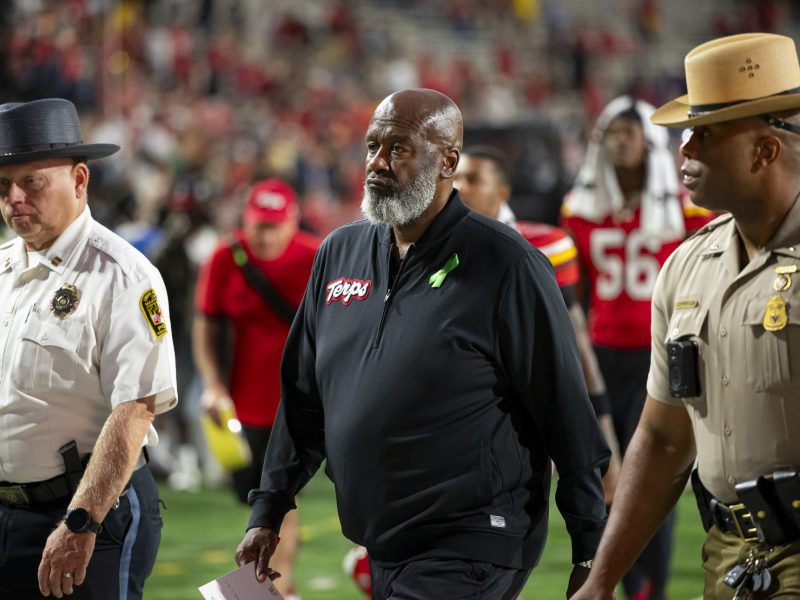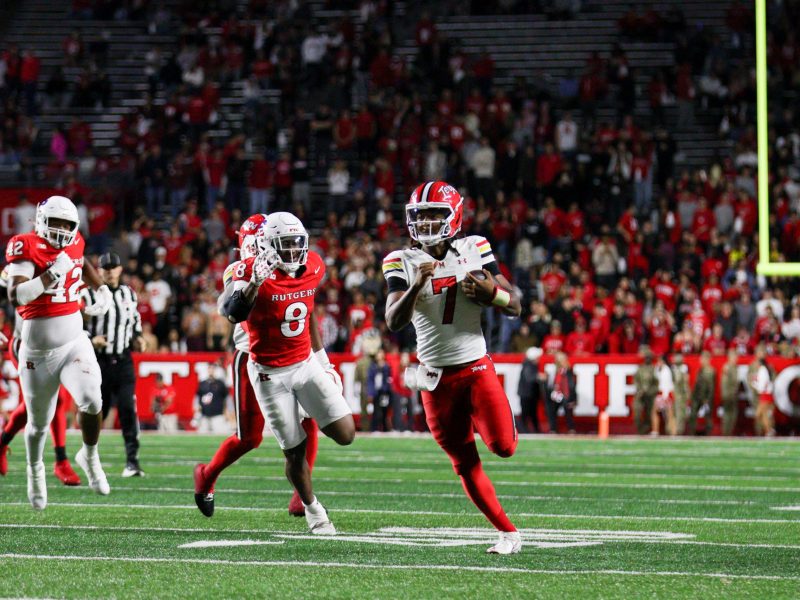Aaron Campbell has worked with Maryland football’s Malik Washington since eighth grade, training him daily in the offseason and serving as his quarterback coach his senior year at Archbishop Spalding.
Their emphasis on footwork helped Washington develop the pocket base he calls “second nature.” Now, Campbell and Washington’s former coaches watch him thrive using the techniques they drilled for years.
“When people see him and they’re amazed, I look at it and I know that he’s worked that drill hundreds and hundreds and hundreds of times,” Campbell said. “To see his hard work pay off is just the coolest thing in the world because none of this is by accident.”
With the Terps ahead 14 in the second quarter against the Badgers, Washington settled in. The freshman opened the drive at Maryland’s 30-yard line with a 19-yard completion to receiver Octavian Smith Jr. He faked an outside zone run, whipped his eyes downfield and reset his base before lofting a pass down the right sideline.
The footwork mirrored a drill Campbell calls “brake and claim,” where Washington plants with his off foot to slow his roll, then regains balance for a clean throw.
“This is literally textbook,” Campbell said. “I got thousands of videos of us working this.”
— Mike Howes Clips (@mikehowesclips) October 1, 2025
Washington threw an 18-yard pass to receiver Kaleb Webb a minute later — backpedaling in the pocket before shuffling to a stop and firing a high-arching ball that dropped just beyond multiple defenders’ reach.
The sequence was what Campbell calls a “Brady step,” a shuffle reset that replaces a three-step drop and lets Washington stay balanced to deliver touch throws over the middle.
— Mike Howes Clips (@mikehowesclips) October 1, 2025
[Maryland football mailbag: Terps aim to return to national relevancy after strong start]
The drive ended with a field goal that stretched Maryland’s lead to 17-0 — only minutes before Washington uncorked a deep ball at the end of the half.
Campbell pointed out that many young quarterbacks linger too long after a play fake. But Washington snapped his head around off a play action fake, reset his base and fired a 48-yard strike under pressure to set up a field goal before halftime.
“Coach [Michael Locksley] called the shot play. We came out of it. I saw a good leverage,” Washington said. “I knew [Smith] is a guy that can fly, so I put the ball out there and let him make the play.”
Some people are surprised
I’m not
@malikw2025 pic.twitter.com/ZCa2FvHYaM
— Coach Aaron (@CoachAaronRHA) September 23, 2025
Washington connected on a 62-yard strike to Shaleak Knotts in the fourth quarter, stretching Maryland’s lead further — not the first time the Terps dialed up the shot. Earlier, Washington overthrew Webb on a similar route that could have gone for a 42-yard score. The quarterback said he adjusted by putting more air under the ball.
Locksley said he saw the freshman “self-correct within the game,” a trait Spalding coach Kyle Schmitt remembered witnessing often in Washington’s high school career.
Schmitt said Washington rarely made the same mistake twice, recalling how he would miss a throw early but return determined to complete it later. That competitiveness, paired with his constant communication on the sideline, made him “a master” at in-game adjustments.
“He plays so balanced … [but] he feels like he’s pissed off that he didn’t hit that earlier,” Schmitt said.
The Cavaliers’ coach remembered Washington insisting on re-running plays he missed in practice, and if Spalding faced an opponent he had misfired against again in the postseason, he would try to hit the same play the next time.
“It’s just a kid that loves football and lives and breathes it,” Schmitt said. “The ability to self-correct in game is a trait of great players … he’s special with that.”
Locksley noted today that he hasn’t seen Malik Washington repeat the same mistake.
He pointed to Washington’s fourth-quarter touchdown to Shaleak Knotts after missing Kaleb Webb on the same play earlier.
“He made the adjustment … saw him self-correct within the game.” pic.twitter.com/sxNP0oO7hO
— Michael Howes (@Mikephowes) September 22, 2025
Maryland has used Washington’s legs sparingly this season — he has just nine carries — but in consecutive weeks the Terps dialed up nearly identical quarterback keepers at the goal line, resulting in touchdowns against Wisconsin and Towson.
[The Diamondback Sports Digest: Malik Washington is exciting Maryland football fans]
Former coaches say that reluctance to run has been part of Washington’s game, despite the 6-foot-5, 231-pound quarterback’s stature. Schmitt recalled challenging him to run more as a junior at Spalding — Washington rushed for 534 yards and 15 touchdowns over his last two high school seasons.
“You start to challenge him … and that pisses him off in a good way,” he said.
Kerwin Porter, Washington’s youth coach with the Brooklyn Park Broncos from ages eight to 13, remembered constantly urging him to “run more.” Porter laughed that, for all of Washington’s hesitancy, he never saw him caught from behind.
— Mike Howes Clips (@mikehowesclips) October 1, 2025
Schmitt said Washington’s legs are most effective in selective spots — short-yardage or red-zone situations — and in scrambles when plays break down and Washington’s ability to create can separate him.
Beyond his play, Washington’s program-building presence has already shown at College Park.
Schmitt recalled how he attracted “winners” to Spalding’s roster, and Maryland has seen a similar effect — 14 DMV recruits joined him in his 2025 class, with nine more committed for 2026.
“The maturity piece — how he elevated the Spalding program. We’re starting to see that here,” Locksley said. “People want to play with him.”



